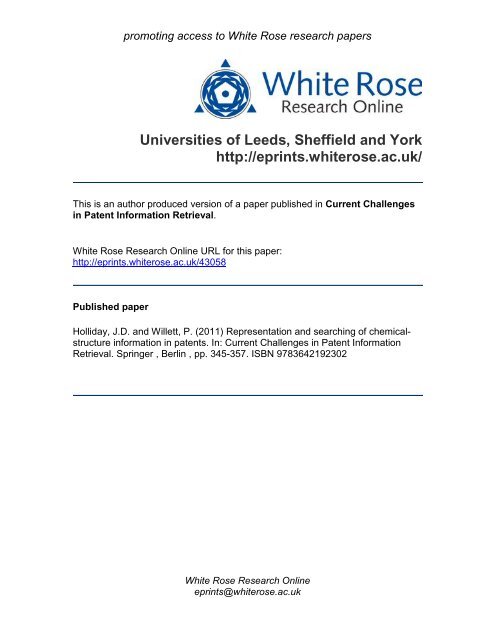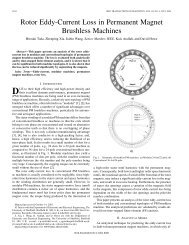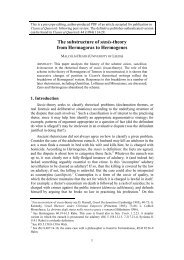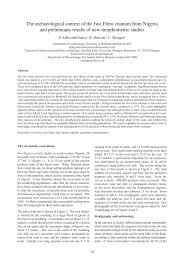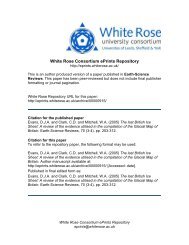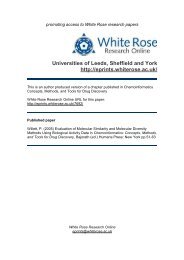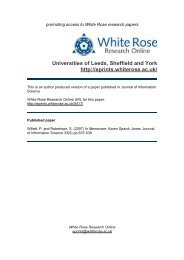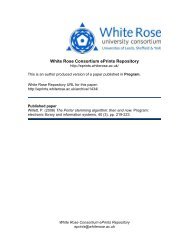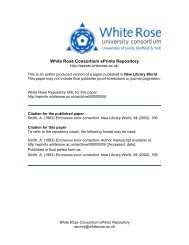Download (312Kb) - White Rose Research Online
Download (312Kb) - White Rose Research Online
Download (312Kb) - White Rose Research Online
You also want an ePaper? Increase the reach of your titles
YUMPU automatically turns print PDFs into web optimized ePapers that Google loves.
promoting access to <strong>White</strong> <strong>Rose</strong> research papers<br />
Universities of Leeds, Sheffield and York<br />
http://eprints.whiterose.ac.uk/<br />
This is an author produced version of a paper published in Current Challenges<br />
in Patent Information Retrieval.<br />
<strong>White</strong> <strong>Rose</strong> <strong>Research</strong> <strong>Online</strong> URL for this paper:<br />
http://eprints.whiterose.ac.uk/43058<br />
Published paper<br />
Holliday, J.D. and Willett, P. (2011) Representation and searching of chemicalstructure<br />
information in patents. In: Current Challenges in Patent Information<br />
Retrieval. Springer , Berlin , pp. 345-357. ISBN 9783642192302<br />
<strong>White</strong> <strong>Rose</strong> <strong>Research</strong> <strong>Online</strong><br />
eprints@whiterose.ac.uk
Representation and Searching of Chemical<br />
Structure Information in Patents<br />
John D. Holliday and Peter Willett<br />
Information School, University of Sheffield,<br />
211 Portobello Street, Sheffield S1 4DP, UK<br />
Abstract<br />
This chapter describes the techniques that are used to represent and to<br />
search for molecular structures in chemical patents. There are two types of<br />
structures: specific structures that describe individual molecules; and generic<br />
structures that describe sets of structurally related molecules. Methods<br />
for representing and searching specific structures have been well established<br />
for many years, and the techniques are also applicable, albeit<br />
with substantial modification, to the processing of generic structures.<br />
KEYWORDS.<br />
Chemical patent, chemoinformatics, connection table, fingerprint, generic<br />
structure, linear notation, Markush structure, similarity searching, structure<br />
searching, substructure searching
2<br />
X.1 Introduction<br />
Patents are a key information resource for all types of industry, but this is<br />
particularly the case in the pharmaceutical and agrochemical industries.<br />
The main focus of these industries is to identify novel chemical molecules<br />
that exhibit useful biological activities, e.g., reducing an individual’s cholesterol<br />
level or killing the insect pest of a crop (Barnard 1984; Berks<br />
2001). Chemical patents hence need to contain not just the textual information<br />
that one would find in any type of patent, but also information<br />
about the chemical molecules of interest. These can, of course, be described<br />
by their chemical names or images, but these provide only limited<br />
searching facilities that are not sufficient to meet the requirements of modern<br />
industrial research and development. Instead, specialised types of representation<br />
and search algorithm have had to be developed to provide efficient<br />
and effective access to the structural information contained in<br />
patents. These techniques are an important component of what has come<br />
to be called chemoinformatics (Willett 2008), i.e., “the application of informatics<br />
methods to solve chemical problems” (Gasteiger 2006).<br />
Two types of molecular information are encountered in chemical patents.<br />
A patent may be based on just a single specific molecule, in which case<br />
the techniques that have been developed in chemoinformatics over many<br />
years may be applied, as discussed below. However, the majority of<br />
chemical patents discuss not single molecules, but entire classes of structurally<br />
related molecules, with these classes being described by a generic,<br />
or Markush, structure. A single generic structure can represent many<br />
thousands, or even a potentially infinite number, of individual molecules,<br />
and the representational and searching techniques required are accordingly<br />
far more complex than those commonly encountered in chemoinformatics
systems. In this paper, we provide an overview of the techniques that are<br />
used to handle both specific and generic chemical structures. The reader is<br />
referred to the standard texts by Leach and Gillet (2007) and by Gasteiger<br />
and Engel (2003) for further details of the techniques described below;<br />
these books also provide excellent introductions to the many aspects of<br />
chemoinformatics that are not, as yet, of direct relevance to the processing<br />
of chemical patent information.<br />
3<br />
X.2 Searching specific chemical structures<br />
X.2.1 Representation of chemical structures<br />
If one wishes to carry out computer-based searches of a chemical database<br />
then the molecules of interest must be encoded for searching, and we commence<br />
by describing the three main ways in which one can provide a full description<br />
of a chemical structure in machine-readable form: these are systematic<br />
nomenclature, linear notations, and connection tables. Before<br />
describing these, the reader should note that we consider here (and in the remainder<br />
of this chapter) only the processing of 2D chemical molecules, i.e.,<br />
the planar chemical structure diagrams that are conventionally used to represent<br />
molecules in the scientific literature and that are exemplified by the<br />
structure diagram shown in Figure 1. More sophisticated techniques are required<br />
for the representation and searching of 3D chemical molecules, i.e.,<br />
where one has geometric coordinate information for all of a molecule’s constituent<br />
atoms (Martin and Willett 1998).<br />
Chemical compounds have had names associated with them ever since the<br />
days of the alchemists, but it was many years before it was realised that there
4<br />
was a need for systematic naming conventions to ensure that every specific<br />
molecule would have its own unique name. This name should be unique, in<br />
the sense that there should be only one possible name for a molecule, and<br />
unambiguous, in the sense that it should describe that molecule and no other;<br />
moreover, it was soon realised that the name should describe the various substructural<br />
components comprising the molecule, whereas common, nonsystematic<br />
names will normally say little or nothing about a molecule’s components.<br />
For example, 2-acetoxybenzoic acid is the systematic, explicit representation<br />
for the structure shown in Figure 1, which is also, and most<br />
commonly, called aspirin.<br />
Two systematic nomenclatures are in widespread use, these being the ones<br />
developed by the International Union of Pure and Applied Chemistry<br />
(IUPAC at http://www.iupac.org) and by Chemical Abstracts Service (CAS<br />
at http://www.cas.org). IUPAC is an association of 60 national chemical societies,<br />
seeking to establish standards in nomenclature and physiochemical<br />
data measurement, while CAS is a division of the American Chemical Society<br />
and the world’s largest provider of chemical information, indexing articles<br />
from more than 10,000 journals and patents from 60 national patent agencies.<br />
Systematic names continue to be widely used in the chemical literature, but<br />
are of less importance in chemoinformatics systems since they are normally<br />
converted automatically into one of the two other types of standard representation,<br />
i.e., linear notations or connection tables. A linear notation is a string<br />
of alphanumeric characters that provides a complete, albeit in some cases<br />
implicit, description of the molecule's topology. A canonicalisation procedure<br />
is normally invoked to ensure that there is a unique notation for each<br />
molecule. The first notation to be widely used was the Wiswesser Line Notation,<br />
which formed the basis for most industrial chemoinformatics systems
in the Sixties and Seventies. Two notations are of importance in present-day<br />
systems: the SMILES (for Simplified Molecular Input Line Entry Specification)<br />
notation developed by Daylight Chemical Information Systems Inc.<br />
(Weininger 1988) and the International Chemical Identifier (or InChI), the<br />
development of which is being overseen by IUPAC. SMILES was developed<br />
for use in in-house industrial chemoinformatics systems (as is the case<br />
with much chemoinformatics software) while InChI, conversely, has been<br />
developed as an open-source, non-proprietary notation. The SMILES and<br />
the InChI for aspirin are included in Figure 1.<br />
5<br />
Notations provide a compact molecular representation, and are thus widely<br />
used for compound exchange and archival purposes. However, most<br />
chemoinformatics applications will require their conversion to a connection<br />
table representation of molecular structure. A connection table is a data<br />
structure that lists the atoms within a molecule and the bonds that link those<br />
atoms together (in many cases, only heavy atoms are included since the presence<br />
of hydrogen atoms can be deduced automatically). The table provides a<br />
complete and explicit description of a molecule’s topology, i.e., the way that<br />
it is connected together, whereas this information is normally only implicit in<br />
a linear notation. There are many ways in which the atoms and bonds can be<br />
encoded, with typical connection table formats being exemplified by those<br />
developed by MDL Information Systems Inc. (now Accelrys Inc.) (Dalby et<br />
al. 1992). A sample connection table for aspirin is shown in Figure 1 where,<br />
for example, the first line shows that atom number 1 (Oxygen) is connected<br />
by a double bond (D) to atom number 2.
6<br />
1<br />
O<br />
O<br />
3<br />
2<br />
4<br />
5<br />
9<br />
6<br />
8<br />
7<br />
O<br />
10<br />
O<br />
13<br />
11<br />
12<br />
InChI: 1S/C9H8O4/c1-6(10)13-8-5-3-2-4-7(8)9(11)12/h2-5H,1H3,(H,11,12)<br />
Smiles: CC(=O)Oc1ccccc1C(=O)O<br />
Name: 2-acetoxybenzoic acid<br />
Connection Table: 1 O D 2<br />
2 C D 1 S 3 S 4<br />
3 O S 2<br />
4 C S 2 D 5 S 9<br />
5 C D 4 S 6<br />
6 C S 5 D 7<br />
7 C D 6 S 8<br />
8 C S 7 D 9<br />
9 C S 4 D 8 S 10<br />
10 O S 9 S 11<br />
11 C S 10 D 12 S 13<br />
12 O D 11<br />
13 C S 11<br />
Fig. 1: Structure, name, InChI, SMILES and<br />
connection table for aspirin<br />
A connection table is an example of a graph, a mathematical construct that<br />
describes a set of objects, called nodes or vertices, and the relationships,<br />
called edges or arcs, that exist between pairs of these objects (Diestel 2000;<br />
Wilson 1996). This means that chemoinformatics has been able to draw on<br />
the many algorithms that have been developed previously for the processing<br />
of graphs. Of particular importance in the present context are the graph iso-
morphism algorithms that are used to determine whether two graphs are identical<br />
and the subgraph isomorphism algorithms that are used to determine<br />
whether one graph is contained within another, larger graph (Gasteiger and<br />
Engel 2003; Leach and Gillet 2007).<br />
7<br />
X.2.2 Searching for specific molecules<br />
An important search capability is structure searching: the inspection of a database<br />
to retrieve the information associated with a particular molecule (e.g.,<br />
if a chemist needed to know the molecule’s boiling point or to identify a synthesis<br />
for it) or to confirm the molecule’s presence or absence in a database<br />
(e.g., if a chemist wanted to check whether a newly synthesised molecule<br />
was completely novel).<br />
Structure searching in files of systematic nomenclature or linear notations is<br />
effected using conventional computer science techniques for single-key<br />
searching. These are typically based on hash coding, where an alphanumeric<br />
string (in this context, a systematic name or a canonicalised notation), is converted<br />
algorithmically to an integer identifier that acts as a key to the molecule’s<br />
location on disk storage. A similar idea underlies the searching of<br />
connection table records; however, whereas names and notations are linear<br />
strings that can be converted into a canonical form very easily; this is not the<br />
case with connection tables and additional processing is required if hashing<br />
is to be used to enable fast structure searching. The generation of a canonical<br />
connection table requires the nodes of the chemical graph to be numbered,<br />
and there are up to N! possible sets of numberings for an N-node graph. Following<br />
initial work by Gluck (1965), Morgan (1965) described an algorithm<br />
to impose a unique ordering on the nodes in a graph, and hence to generate a
8<br />
canonical connection table that can then be used for structure searching.<br />
With subsequent development (Freeland et al. 1979; Wipke and Dyott 1974),<br />
the resulting procedure, which is known to this day as the Morgan algorithm,<br />
forms the basis for all CAS databases and for many other chemoinformatics<br />
systems.<br />
Hashing is an approximate procedure, in that different records can yield the<br />
same hashed key, a phenomenon that computer scientists refer to as a collision.<br />
In nomenclature and notation systems, collisions are avoided by means<br />
of a subsequent, and extremely simple, string comparison that confirms the<br />
equivalence of the query molecule and the molecule that is stored in the database<br />
that is being searched. In connection table systems, a graph isomorphism<br />
algorithm is used to confirm that a true match has been achieved, this<br />
involving an exhaustive, tree-search procedure in which nodes and edges<br />
from the graph describing the query molecule are mapped to nodes and edges<br />
of the graph describing a potentially matching database molecule. The mapping<br />
is extended till all the nodes have been mapped, in which case a match<br />
has been identified; or until nodes are found that cannot be mapped, in which<br />
case, the mapping backtracks to a previous, successful sub-mapping and a<br />
different mapping attempted. A mis-match is confirmed if no match has<br />
been obtained and if there are no further mappings available for testing. It<br />
will be realised that the mapping procedure has a time complexity that is a<br />
factorial function of the numbers of graph nodes involved in the comparison,<br />
and that the procedure can thus be very demanding of computational resources.<br />
Fortunately, various heuristics are available to expedite the identification<br />
of matches, and the use of the Morgan algorithm means that very few<br />
mis-matches need to be probed, making the overall procedure rapid in operation<br />
despite the complexity of the processing that is necessary.
X.2.3 Searching for chemical substructures<br />
9<br />
Probably the single most important facility in a chemoinformatics system is<br />
the ability to carry out a substructure search, i.e., the ability to identify all of<br />
those molecules in a database that contain a user-defined query substructure.<br />
For example, in a search for molecules with antibiotic behaviour, a user<br />
might wish to retrieve all of the molecules that contain a penicillin or cephalosporin<br />
ring system. Substructure searching is effected by checking the<br />
graph describing the query substructure for inclusion in the graphs describing<br />
each of the database molecules. This is an example of subgraph isomorphism:<br />
it involves an atom-by-atom and bond-by-bond mapping procedure<br />
that is analogous to, but more complex than, that used for a graph isomorphism<br />
search. A substructure search guarantees the retrieval of all molecules<br />
matching the search criterion: unfortunately, although it is completely effective,<br />
subgraph isomorphism is extremely inefficient since it belongs to the<br />
class of NP-complete computational problems for which no efficient algorithms<br />
are known to exist (Barnard 1993; Leach and Gillet 2007).<br />
O<br />
N<br />
Query<br />
N<br />
N<br />
N<br />
O<br />
N<br />
O<br />
N<br />
N<br />
N<br />
N<br />
Fig. 2. Query substructure and some example hits in a search for a pyridine<br />
ring<br />
Operational substructure searching is practicable for three reasons. First, the<br />
fact that chemical graphs are both simple (they contain relatively few nodes,
10<br />
most of which are of very low connectivity) and information-rich (as one can<br />
differentiate atoms and bonds by their element and bond-types, respectively).<br />
These factors serve to reduce the numbers of atom-to-atom and bond-to-bond<br />
mappings that need to be considered by a subgraph isomorphism algorithm.<br />
Second, a lot of effort has gone into the development of algorithms that can<br />
handle chemical graphs, as against graphs in general, very efficiently, with<br />
the elegant matching techniques described by Sussenguth (1965) and by<br />
Ullmann (1976) lying at the heart of current substructure searching systems.<br />
Third, and most importantly, the subgraph isomorphism search is preceded<br />
by an initial screening search in which each database structure is checked for<br />
the presence of features, called screens, that are present in the query substructure.<br />
For example, using the penicillin example mentioned above, any<br />
database structure can be eliminated from further consideration if it does not<br />
contain the fused four-membered and five-membered rings that comprise the<br />
penicillin nucleus.<br />
A screen is a substructural feature, called a fragment, the presence of which<br />
is necessary, but not sufficient, for a molecule to contain the query substructure.<br />
The features that are used as screens are typically small, atom-, bondor<br />
ring-centred fragment substructures that are algorithmically generated<br />
from a connection table when a molecule is added to the database that is to<br />
be searched. A common example of a screen is the augmented atom fragment,<br />
which consists of an atom, and those atoms that are bonded directly to<br />
the chosen central atom. A representation of the molecule’s structure can<br />
then be obtained by generating an augmented atom fragment centred on each<br />
atom in the molecule in turn. This information is encoded for rapid searching<br />
in a fixed-length bit-string, called a fingerprint, whose encoded fragments<br />
hence provide a summary representation of a molecule’s structure in
just the same way as a few selected keywords provide a summary representation<br />
of the full text of a document. The fingerprint representing the query<br />
can then be matched against corresponding fingerprints representing each of<br />
the molecules in the database that is to be searched. Only a very small subset<br />
of a database will normally contain all of the screens that have been assigned<br />
to a query substructure, and only this subset then needs to undergo the timeconsuming<br />
subgraph isomorphism search.<br />
11<br />
Fig. 3. Example of augmented atoms and a fingerprint<br />
X.2.4 Similarity searching<br />
Substructure searching provides an invaluable tool for accessing databases<br />
of chemical structures; however, it does require that the searcher is able to<br />
provide a precise definition of the substructure that is required, and this<br />
may not be possible in the early stages of a drug-discovery project, where<br />
all that is known is the identity of one or more active molecules, e.g., an<br />
existing drug from a competitor company. In such circumstances, an alternative<br />
type of searching mechanism is appropriate, called similarity<br />
searching (Eckert and Bajorath 2007; Willett 2009). Here, the searcher<br />
submits an entire molecule, which is normally called the reference struc-
12<br />
ture, and the system then ranks the database in order of decreasing similarity<br />
with the reference structure, so that the molecules returned first to the<br />
searcher are those that are most closely related to it in structural terms.<br />
The underlying rationale for similarity searching is the Similar Property<br />
Principle (Johnson and Maggiora 1990), which states that molecules that<br />
have similar structures will have similar properties. Hence, if the reference<br />
structure has some interesting property, such as reducing a person’s susceptibility<br />
to angina, then structurally similar molecules are also likely to<br />
exhibit this characteristic.<br />
There are many different ways in which inter-molecular structural similarity<br />
can be quantified, with the most common similarity measures being<br />
based on the comparison of molecular fingerprints to identify the numbers<br />
of fragments common to a pair of molecules. This provides a very simple,<br />
but surprisingly, effective way of identifying structural relationships, as<br />
exemplified by the molecules shown in Figure 4. However, we shall not<br />
discuss similarity searching any further here, since similarity-based approaches<br />
have not, to date, been considered in much detail for searching<br />
the generic structures that form the principal focus of this chapter. This<br />
may, of course, change in the future as techniques for searching chemical<br />
patents become more widely used and as more sophisticated searching<br />
methods become necessary for effective database access. For example,<br />
Fliri et al. (2009, 2010) have recently described the use of fingerprintbased<br />
similarity methods to search sets of molecules randomly enumerated<br />
from Markush structures (see Section X.3.4).
13<br />
Fig. 4. Example of output from a similarity search<br />
X.3 Searching generic chemical structures<br />
X.3.1 Markush structure representation<br />
In order to ensure complete coverage of the scope of invention, and hence<br />
protect the inventor’s property rights, patent documents tend to extend beyond<br />
the realm of specific description but, instead, describe the invention<br />
using broader terms. Those features which reflect the novelty of the invention<br />
are described in full and unambiguous terms, whilst other features,<br />
although fundamental to the invention, may be optional or alternative in<br />
nature. An example of the latter feature might be a new refrigerator for<br />
which the internal light might be described using a vague term such as<br />
“device for illuminating the interior”. The same is true of chemical patents<br />
in which features of the compound which are fundamental to the<br />
novelty of its operation are described using specific terms, and those for<br />
which alternatives may be substituted are described generically. The result<br />
of this treatment is a single description which can represent a potentially<br />
vast number of specific molecules, many (or even most) of which<br />
will have never been synthesised or tested.
14<br />
The logical and linguistic terminology that exists in the chemical patent<br />
literature has been described in detail by Dethlefsen et al. (1991), leading<br />
to a classification of the structural variations which exist. These authors<br />
identified four types of structural variation, which are exemplified in Figure<br />
5. Substituent variation involves the (possibly optional) set of alternative<br />
components which may be attached at a fixed point of substitution<br />
(e.g., R1 in the figure); position variation involves the alternative positions<br />
of attachment between two components of the molecule (e.g., R2). Frequency<br />
variation involves the repetition of a component either within a<br />
linear sequence or as an attachment to a ring system (e.g., n, indicating the<br />
presence of between 1 and 2 occurrences of the –O-CH 2 - substructure);<br />
and homology variation involves the use of terminology which is itself generic<br />
in nature and which defines the component as being a member of a<br />
family of related chemical substituents (e.g., R4 in the figure indicating an<br />
alkyl group member containing 1, 2 or 3 carbon atoms).<br />
R4<br />
R1<br />
O<br />
n<br />
R2<br />
R1 is optionally F, Cl or Br<br />
R2 is OH or CH 3<br />
R4 is C 1-3 alkyl<br />
n = 1-2<br />
Fig. 5: Examples of structure variation in generic chemical structures
Figure 5 illustrates a relatively simple generic structure, but repeated nesting<br />
of alternative components within parent components is a common feature<br />
in chemical patents, leading to a complex and often confusing structure.<br />
Enumeration of all of these the specific molecules is rarely an option<br />
due to storage requirements and computational costs. Therefore, an alternative<br />
method of computer representation is required. The basic structure<br />
adopted by current commercial systems (Berks 2001) is a logical tree in<br />
which the invariant core of the structure, the graphical component in Figure<br />
5 for example, becomes the root. The various optional and alternative<br />
components become the branches of the tree, and the logical and connectional<br />
relationships are maintained within the representation (Barnard et al.<br />
1982), as exemplified in Figure 6.<br />
15<br />
The logical tree encodes all of the linkages, potential or actual, within the<br />
set of molecules covered by a Markush structure, and it can hence be regarded<br />
as a form of connection table, albeit one that is far more complex<br />
that that used to describe a single specific molecule.<br />
Fig. 6: Tree representation of a generic structure
16<br />
X.3.2 Representational transparency<br />
The representation of the components themselves in the tree depends on<br />
whether they are specific or generic in nature, the latter being the instance<br />
of homology variation. Specific components can be represented by a connection<br />
table, or even a line notation, whereas components relating to a<br />
chemical family, or homologous series, require alternative means. In the<br />
latter case, the representation is usually a single node which may be labelled<br />
according to the family group, and which is usually qualified by<br />
further attributes such as the number of carbon atoms or number of rings<br />
present. In the Markush DARC system, which originated from a collaboration<br />
between Derwent Publications and the French Patent Office INPI,<br />
(now called the Merged Markush Service, MMS, and produced by Thomson<br />
Reuters) these are termed “Superatoms”, whilst the MARPAT system<br />
produced by CAS uses “Hierarchical Generic Groups”.<br />
Whichever method is employed, there remains the problem of transparency<br />
between the two types of representation, i.e., the lack of a common representation<br />
across components. During a search operation, whether for a<br />
structure or for a substructure, the aim is to identify mappings between the<br />
components of the query structure and those of the database structure. This<br />
operation is complicated by the requirement to map features which are<br />
specific in one representation with those which may be generic in others, a<br />
one-to-many mapping, or even features which are generic in both. In order<br />
to overcome this transparency problem, a common representation is usually<br />
sought so that the mapping becomes like-for-like. The enumeration of<br />
all possible specific members of the homologous series is again usually<br />
not an option, so a more appropriate step is the aggregation of specific<br />
components into their respective generic nodes. In the Sheffield Generic
Structures Project (Lynch and Holliday 1996), several aggregation methods<br />
were investigated, leading to a transparent representation called a reduced<br />
graph (Gillet et al. 1987). Figure 7 illustrates an example of such a<br />
graph in which aggregation is based on the ring (R) or non-ring nature of<br />
the features, and on further subdividing the non-ring features into those<br />
which are all carbon (C) and those which are non-carbon (Z).<br />
17<br />
Fig. 7: Reduced graph representation of the generic structure of Figure<br />
6 (optional connections are indicated by a dotted line)<br />
Since we now have a common representation, one-to-one mapping can be<br />
carried out between the query and database structure. The final, and now<br />
less complex, stage is to map the constituent features of the matching query<br />
node and the database node. These are still likely to contain generic<br />
and/or specific components, but the operation is now more localised and<br />
much simpler and can be implemented using a modified version of<br />
Ullmann’s subgraph isomorphism algorithm (Holliday and Lynch 1995)
18<br />
X.3.3 Fragmentation codes and screening<br />
Early structure-based retrieval systems operated almost exclusively on the<br />
basis of fragmentation codes in which the structural components were described<br />
using a series of fragment descriptors that were analogous in principle<br />
to the fragments used for screening substructure searches of databases<br />
of specific molecules. The most notable fragmentation codes were<br />
the Derwent Chemical Code used by Derwent Publications Ltd. (Simmons<br />
1984), the DuPont/IFI code (Kaback 1984) and the GREMAS code from<br />
International Documentation in Chemistry (Suhr 1984). The GREMAS<br />
system was highly effective and it was later possible to generate the codes<br />
automatically from the structure representation (Rössler and Kolb 1970).<br />
As with specific structure searching, graph-based generic systems, such as<br />
MARPAT and Markush DARC, also require an initial fragment-based<br />
screening stage in order to reduce the number of compounds being sent to<br />
more computer intensive search strategies. In addition to the standard<br />
screens used at CAS for searching specific molecules, the MARPAT system<br />
uses generic group screens in which the components are reduced to<br />
their Hierarchical Generic Groups. The Markush DARC system also extended<br />
their existing specific search screens with the addition of Fuzzy<br />
FRELs (where a FREL is a circular fragment that can be considered as a<br />
larger version of the augmented atom discussed previously; some of these<br />
fuzzy FRELs were defined in terms of Superatoms and others reflected<br />
specific local variations. In the system developed at Sheffield, the approach<br />
was to generate specific fragment descriptors from the generic<br />
components (Holliday et al. 1993). Two types of screen were developed:<br />
those from the invariant components of the molecule, i.e. those alternatives<br />
which are common to all molecules covered by the generic; and
those which would be optional depending on the individual specific molecules<br />
being considered at any point. In Figure 5, for instance, a screen denoting<br />
a halogen would be common to all molecules, with a logical “bubble-up”<br />
of all screens from the branches of the tree to its root maintaining<br />
the logical relationships between screens (Downs et al. 1989).<br />
19<br />
X.3.4 Recent Developments<br />
More recently, there has been renewed interest in Markush structures; in<br />
part due to the increased computer power which was not available when<br />
the current systems first evolved. One area of interest is the application of<br />
Oracle relational database systems for storing and searching Markush<br />
structures (Barnard and Wright 2009; Csepregi et al. 2009). Many of the<br />
new developments do not, however, deal with all types of structure variation,<br />
and rely on the same philosophy of extending current systems for<br />
handling specific chemical structures.<br />
Two other areas of interest are the automatic extraction of structural information<br />
from the patent documents (Valko and Johnson 2009; Zimmermann<br />
et al. 2005) and enumeration of specific compounds from the<br />
Markush structure. Chemical patent documents contain structures for the<br />
specific claim as well as a selection of examples. Although these usually<br />
represent a very small proportion of the possibly infinite number of compounds<br />
represented by the Markush structure, they are clearly a rich<br />
source of information and are indexed accordingly. A further source of<br />
structural information comes from the translation of nomenclatural terms<br />
identified in the document, as in the SureChem database and search system<br />
(at http://www.surechem.org). Full enumeration of all represented
20<br />
compounds is not possible for most structures due to the combinatorial<br />
complexity. However, as noted previously, sets of randomly enumerated<br />
specifics have been used for similarity searching, enabling rapid patent<br />
analysis and virtual library creation (Fliri et al. 2009; Fliri et al. 2010).<br />
X.4 Conclusions<br />
The structures of chemical molecules are an important component of the<br />
information contained in chemical patents. Individual molecules can be<br />
searched using well-established techniques from chemoinformatics, and<br />
substantial enhancements to these techniques have allowed them to be<br />
used for the representation and searching of the generic chemical structures<br />
in patents, which can describe very large numbers of structurally related<br />
molecules. In this chapter, we have summarised the techniques that<br />
are currently available for structure and substructure searching of both<br />
specific and generic structures. There are, however, many problems that<br />
remain to be addressed. Most importantly, the very generic descriptions<br />
that are sometimes used in patents mean that very large hit-lists can result<br />
even in response to quite specific structural queries: it is hence likely that<br />
there will be much interest in the future in the use of similarity-based procedures<br />
to rank search-outputs so that attention can be focused on just the<br />
top-ranked structures and patents.<br />
References<br />
Barnard JM (ed) (1984) Computer handling of generic chemical structures.<br />
Gower, Aldershot.<br />
Barnard JM (1993) Substructure searching methods - old and new. J Chem<br />
Inf Comp Sci 33: 532-538.
Barnard JM, Wright PM (2009) Towards in-house searching of Markush<br />
structures from patents. World Pat Inf 31: 97-103.<br />
Barnard JM, Lynch MF et al (1982) Computer storage and retrieval of generic<br />
structures in chemical patents. Part 4. An extended connection<br />
table representation for generic structures. J Chem Inf Comp<br />
Sci 22: 160-164.<br />
Berks AH (2001) Current state of the art of Markush topological search<br />
systems. World Pat Inf 23: 5-13.<br />
Csepregi S, Mate N et al. Csizmadia F (2009) Representation, searching &<br />
enumeration of Markush structures – from molecules towards patents.<br />
http://www.chemaxon.com/library/scientificpresentations/calculator-plugins/representation-searchingenumeration-of-markush-structures-from-molecules-towardspatents-2009-update/.<br />
Accessed 14 September 2010.<br />
Dalby A, Nourse JG et al (1992) Description of several chemical structure<br />
file formats used by computer programs developed at Molecular<br />
Design Limited. J Chem Inf Comp Sci 22: 244-255.<br />
Dethlefsen W, Lynch MF et al (1991) Computer storage and retrieval of<br />
generic chemical structures in patents, Part 11. Theoretical aspects<br />
of the use of structure languages in a retrieval system. J Chem Inf<br />
Comp Sci 31: 233-253.<br />
Diestel R (2000) Graph theory. Springer-Verlag, New York.<br />
Downs GM, Gillet VJ et al (1989) Computer storage and retrieval of generic<br />
chemical structures in patents, Part 10. Assignment and logical<br />
bubble-up of ring screens for structurally explicit generics. J<br />
Chem Inf Comp Sci 29: 215-224.<br />
Eckert H, Bajorath J (2007) Molecular similarity analysis in virtual screening:<br />
foundations, limitation and novel approaches. Drug Discov<br />
Today 12: 225-233.<br />
Fliri A, Moysan E, et al (2009) Methods for processing generic chemical<br />
structure representations. US Patent 2009/0132464.<br />
Fliri A, Moysan E, Nolte M (2010) Method for creating virtual compound<br />
libraries within Markush structure patent claims. WO Patent<br />
2010/065144 A2.<br />
Freeland R, Funk S et al (1979) The Chemical Abstracts Service Chemical<br />
Registry System. II. Augmented Connectivity Molecular Formula.<br />
J Chem Inf Comp Sci 19: 94-98.<br />
Gasteiger, J (2006) The central role of chemoinformatics. Chemomet Intell<br />
Lab Syst 82: 200-209.<br />
Gasteiger J, Engel T (eds) (2003) Chemoinformatics: A textbook. Wiley-<br />
VCH, Winheim.<br />
21
22<br />
Gillet VJ, Downs GM et al (1987) Computer-storage and retrieval of generic<br />
chemical structures in patents. 8. Reduced chemical graphs<br />
and their applications in generic chemical-structure retrieval. J<br />
Chem Inf Comp Sci 27: 126-137.<br />
Gluck DJ (1965) A chemical structure storage and search system developed<br />
at DuPont. J Chem Doc 5: 43-51.<br />
Holliday J D, Downs GM et al (1993) Computer storage and retrieval of<br />
generic chemical structures in patents, Part 15. Generation of topological<br />
fragment descriptors from nontopological representation of<br />
generic structure components. J Chem Inf Comp Sci 33: 369-377.<br />
Holliday JD, Lynch MF (1995) Computer storage and retrieval of generic<br />
chemical structures in patents. Part 16. The refined search: an algorithm<br />
for matching components of generic chemical structures<br />
at the atom-bond level. J Chem Inf Comp Sci 35: 1-7.<br />
Johnson MA, Maggiora GM (eds) (1990) Concepts and applications of<br />
molecular similarity. John Wiley, New York.<br />
Kaback SM (1984) The IFI/Plenum chemical indexing system. In: Barnard<br />
JM, (ed) Computer handling of generic chemical structures. Gower,<br />
Aldershot.<br />
Leach AR, Gillet VJ (2007) An Introduction to Chemoinformatics.<br />
Kluwer, Dordrecht.<br />
Lynch MF, Holliday JD (1996) The Sheffield Generic Structures Project -<br />
a retrospective review. J Chem Inf Comp Sci 36: 930-936.<br />
Martin YC, Willett P (eds) (1998) Designing bioactive molecules: Threedimensional<br />
techniques and applications. American Chemical Society,<br />
Washington.<br />
Morgan H (1965) The generation of a unique machine description for<br />
chemical structures - a technique developed at Chemical Abstracts<br />
Service. J Chem Doc 5: 107-113.<br />
Rössler S, Kolb A (1970) The GREMAS System, an integral part of the<br />
IDC system for chemical documentation. J Chem Doc 10: 128-<br />
134.<br />
Simmons ES (1984) Central Patents Index Chemical Code: a user’s viewpoint.<br />
J Chem Inf Comput Sci 24: 10-15.<br />
Sussenguth EH (1965) A graph-theoretic algorithm for matching chemical<br />
structures. J Chem Doc 5: 36-43.<br />
Suhr C, von Harsdorf E, Dethlefsen W (1984) Derwent’s CPI and IDC’s<br />
GREMAS: remarks on their relative retrieval power with regard to<br />
Markush structures. In: Barnard JM (ed) Computer handling of<br />
generic chemical structures. Gower, Aldershot.<br />
Ullmann JR (1976) An algorithm for subgraph isomorphism. J ACM 23:<br />
31-42.
Valko AT, Johnson AP (2009) CLiDE Pro: The latest generation of<br />
CLiDE, a tool for optical chemical structure recognition. J Chem<br />
Inf Model 49: 780–787.<br />
Weininger D (1988) SMILES, a chemical language and informationsystem.1.<br />
Introduction to methodology and encoding rules. J Chem<br />
Inf Comp Sci 28: 31-36.<br />
Willett P (2008) From chemical documentation to chemoinformatics: fifty<br />
years of chemical information science. J Inf Sci 34: 477-499.<br />
Willett P (2009) Similarity methods in chemoinformatics. Ann Rev Inf Sci<br />
Technol 43: 3-71.<br />
Williams AJ, Yerin A (2009) Automated identification and conversion of<br />
chemical names to structure-searchable information. In: Banville<br />
DL (ed) Chemical Information Mining. CRC Press, Boca Raton.<br />
Wilson R (1996) Introduction to graph theory. Longman, Harlow.<br />
Wipke WT, Dyott TM (1974) Stereochemically unique naming algorithm.<br />
J Am Chem Soc 96: 4825-4834.<br />
Zimmermann M, Thi LTB, Hofmann M. (2005) Combating illiteracy in<br />
chemistry: towards computer-based chemical structure reconstruction.<br />
ERCIM News 60: 40-41.<br />
23


